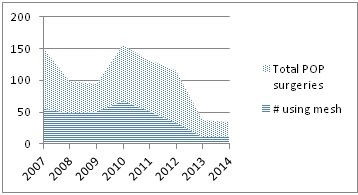|
Back to 2015 Joint Annual Meeting
Trends In The Use Of Mesh For Pelvic Organ Prolapse Surgery
Casey Kowalik, Arthur P Mourtzinos, Lara S MacLachlan
Lahey Hospital & Medical Center, Burlington, MA
Introduction: In 2008 and 2011, the FDA issued notifications regarding adverse events related to the use of transvaginal mesh for pelvic organ prolapse (POP). The effect of these communications on the treatment of POP is unclear. The objective of this study was to identify any changes in the surgical management of POP at our institution.
Methods: Analysis of surgical volume was performed using billing data collected from CPT codes for POP (45560, 57120, 57240, 57250, 57260, 57265, 57268, 57270, 57280, 57282, 57283, 57284, 57285, 57423, 57425), mesh insertion (57267), and mesh revision from 2007 to 2014.
Results: The total number of surgical procedures for POP has decreased from 152 in 2007 to 35 in 2014. The percentage of procedures performed using mesh as a fraction of the total number of POP repairs, has remained stable over this time period (Figure 1). Mesh revision surgery compared to total number of POP procedures has increased from 6% in 2009 to a high of 21% in 2013.
Conclusion: The surgical treatment of POP has decreased over time with an associated decrease in mesh utilization. There has also been an increase in mesh revision surgeries. This could be a reflection of the FDA communications on the use of mesh in transvaginal repair of POP. Other factors could also be influencing this trend including changes in referral patterns and socioeconomic changes.

Back to 2015 Joint Annual Meeting
|

